Lambeth
Explore hidden histories, historic photos, and things you never knew about Lambeth from the collections and archives of Historic England.
Discover your local listed buildings and places
Introducing some of Lambeth's most historic sites, included in the National Heritage List for England. Some of these captions have been summarised by AI. Click through for the official List entry. Skip this section and go to place by numbers
Brixton Recreation Centre
Lambeth
Sports and recreation centre with shops, designed in 1970 by a design team led by George Finch for Lambeth Borough Council, with Ove Arup and Partners as consultant engineers.
IBM Building, South Bank
Lambeth
IBM Marketing Centre, built 1979-1984, to the designs of Denys Lasdun, Redhouse and Softley Architects. Read the official list entry to find out more.
Former Annie McCall Hospital
Lambeth
Former maternity hospital, 1915, by Hart and Waterhouse. Extension of 1938 by Gertrude Leverkus. Minor later alterations. Read the official list entry to find out more.
Brixton Markets - Reliance Arcade, Market Row and Granvil…
Lambeth
Covered markets for fruit, vegetables and sundry goods.
Royal Vauxhall Tavern
Lambeth
The Royal Vauxhall Tavern, 1860-2 probably by the architect James Edmeston the elder, refitted in 1896 and again in the early 1980s, a noted performance space and LGB&T venue.
Platforms Piece
Lambeth
Platforms Piece, a three-figure sculptural group of 1985-1986, by Kevin Atherton. Read the official list entry to find out more.
Former Waterloo Road Fire Station
Lambeth
Former Waterloo Road Fire Station, 1908-11, for the London County Council, possibly by HFT Cooper under the superintendence of Owen Fleming and Charles Canning Winmill.
No 1 gasholder, Kennington Lane Gasholder Station
Lambeth
Gasholder. Built in 1877-9 by Corbet Woodall for the Phoenix Gas Light and Coke Company and enlarged in 1891-2 for the South Metropolitan Gas Company by Frank Livesey.
Former Lambeth County Court
Lambeth
Court building, 1928, designed by John Hatton Markham of the Office of Works, in an eclectic classical style.
West Norwood Cemetery and Crematorium
Lambeth
An early C19 cemetery founded in 1837 and originally known as South Metropolitan Cemetery, laid out to the design of William Tite. Read the official list entry to find out more.
1-218 Pullman Court
Lambeth
Pullman Court is a notable 1933-5 development by Sir Frederick Gibberd, showcasing early International Modern style in Britain, inspired by Walter Gropius and German constructivism.
Lambeth Palace
Lambeth
Lambeth Palace has been the residence of the Archbishop of Canterbury since 1197. Its gardens were historically for practicality, later evolving into pleasure grounds.
Lambeth Fire Station (formerly also the London Fire Briga…
Lambeth
The former London Fire Brigade Headquarters Building and Fire Station, known as Lambeth Fire Station in 2023, built to the designs of the LCC architect EP Wheeler FRIBA, assisted by G Weald...
Church of Holy Trinity
Lambeth
The church of Holy Trinity, Clapham, is located to the south of Clapham Common North Side. 1774-6 by Kenton Couse. West porch built in 1812 by Francis Hurlbatt.
Church of St Bede and Institute
Lambeth
Church and institute, by Edward Brantwood Maufe for the Royal Association in aid of the Deaf and Dumb; designed 1923, institute completed 1924, church completed 1935.
10 Dorchester Drive and boundary walls
Lambeth
A detached house in the moderne style, designed by Leslie H Kemp and Frederick E Tasker and built by Cyril and Stanley Morrell 1935-1936.
Following the Leader (Memorial to the Children Killed in …
Lambeth
Sculptural relief in coloured concrete: 'Following the Leader (Memorial to the Children Killed in the Blitz)', 1949 by Peter Laszlo Peri. Mounted on the stair tower of Darley House.
Sculptural relief of Mother and Children Playing
Lambeth
Sculptural relief in coloured concrete. 'Mother and Children Playing', 1951-2 by Peter Laszlo Peri. Mounted on the stair tower of Horton House.
ST MICHAEL'S CONVENT (formerly PARK HILL)
Lambeth
St Michael's Convent, formerly Park Hill, is a 19th-century villa garden in south London, designed by J B Papworth and modified by Robert Marnock for notable figures William Leaf and Sir...
Brixton Fire Station
Lambeth
Fire station, 1904-6, by the Fire Brigade Branch of the London County Council Architects Department. With minor later extensions and alterations.
Carnegie Library, perimeter wall and gatepiers
Lambeth
A large purpose-built library, with its gate piers and boundary walls, 1906, by Wakeford and Sons, and funded by Andrew Carnegie. Read the official list entry to find out more.
Brockwell Park
Lambeth
Brockwell Park, established in 1892 in Lambeth, London, features historic gardens adapted by J J Sexby, a mansion, and various sports facilities, with rich landscape heritage.
Kennington Park
Lambeth
Kennington Park was established in 1854, featuring historic structures like the Prince Albert Lodges, and amenities such as gardens, memorials, and recreational spaces.
West Norwood Memorial Park Augustus Ralli Mortury Chapel …
Lambeth
The Augustus Ralli Mortuary Chapel, a Doric temple in West Norwood Memorial Park, is attributed to J. Oldrid Scott, built circa 1872, featuring Parthenon-style marble sculptures.
Tomb of Michael Emmanuel Rodocanachi and Family in west N…
Lambeth
Chest tomb, c1901. Read the official list entry to find out more.
The Duke of Edinburgh
Lambeth
'Improved' public house, 1936-7, by A E Sewell, for the brewery Truman, Hanbury, Buxton & Co. Ltd. Read the official list entry to find out more.
Bust of Sir Henry Tate, outside Tate Library, Brixton Oval
Lambeth
The bronze bust of Sir Henry Tate by Sir Thomas Brock, dated 1905, and commissioned by Jane Tate, standing to the west of Brixton Tate Library. Read the official list entry to find out more.
Church of St Peter
Lambeth
The Church of St Peter features a tall nave, decorative polychromy, and an elaborate reredos, with architectural parts designed by Drew and Fellowes Prynne.
Clapham Common War Memorial
Lambeth
First World War memorial, later adapted to commemorate the fallen of the Second World War. Read the official list entry to find out more.
Myatt's Fields
Lambeth
William Minet donated Myatt's Fields to create a public park managed by London County Council in 1889, featuring a bandstand and gymnasia for community leisure.
Boundary wall of former graveyard forming the perimeter o…
Lambeth
Graveyard boundary wall, probably originally laid out in the C18 but extended and largely rebuilt in about 1815. There are some C20 alterations or additions, which are of lesser interest.
Bust of Nelson Mandela, Royal Festival Hall, London
Lambeth
A 'Bust of Nelson Mandela', executed 1982, re-cast and re-erected in 1988, by Ian Walters. The sculpture is affixed to a plinth which is located by the south side of the Royal Festival Hall.
War memorial at St John's Church, Waterloo
Lambeth
First World War memorial in the form of a Calvary cross mounted on a plinth. Read the official list entry to find out more.
Ruskin Park
Southwark
Ruskin Park, designed by J J Sexby and opened in 1907, is a 15ha public park in Lambeth, featuring a late 18th-century shelter, a rose garden, and recreational areas.
The Rookery
Lambeth
The Rookery, an early 20th-century public garden in London, features historic spa house grounds, unique white gardens, and scenic terraces. Opened as a public park in 1913.
22-24 Brixton Road
Lambeth
A pair of houses dating from the early C19, with later extension. Read the official list entry to find out more.
Church of St Leonard
Lambeth
Church, c1350 and later including work by J T Parkinson in 1831, William Dyce in 1863, and (following a major fire) the Douglas Feast Partnership in 1975-7.
Explore more
Search for more listed placesLambeth through time
This timeline shows the first period of use for buildings and places on the National Heritage List for England, just one of the details recorded for every list entry. Click around to see how Lambeth changes over time. Skip this section and go to aerial photos
Roman AD 43 to AD 410
Britain was invaded by four legions of the Roman army in AD 43, who relatively rapidly conquered England from landing points in Kent. Parts of Wales and Scotland soon followed.
Roman culture brought urbanism, monumental buildings, wide-ranging religious beliefs, writing, and strong social hierarchy. The Roman administrative system was withdrawn in AD 410.
Medieval AD 1066 to AD 1540
This period, sometimes known as the Middle Ages, began with the Norman invasion in AD 1066. It saw a significant rise in military and defensive buildings such as castles and earthworks, as well as religious houses dominating a largely agricultural landscape.
The monarchy and Church dominated the period, which also saw the break with the Roman Catholic Church and the English reformation.
Post medieval AD 1540 to AD 1901
The Post-Medieval period brought seismic changes to life in England, with religious reformation leading to the democratization of worship and the destruction of hundreds of religious houses.
In parallel, there was a huge expansion of scientific study and enlightenment that permanently altered the nation's social structure and landscape. Industrialization and mass production lead to wider global trade, emigration, and immigration.
20th century AD 1901 to AD 2000
The 20th century saw an incredible expansion of England's transport networks, with suburban growth shadowing rapid infrastructural expansion. The establishment of state schools, hospitals, and modern technical colleges, with new architectural styles, radically changed the appearance of towns and cities.
Two catastrophic world wars and the 1918 pandemic also brought unprecedented change, altering England's built environment and social structures forever.
Roman AD 43 to AD 410
Britain was invaded by four legions of the Roman army in AD 43, who relatively rapidly conquered England from landing points in Kent. Parts of Wales and Scotland soon followed.
Roman culture brought urbanism, monumental buildings, wide-ranging religious beliefs, writing, and strong social hierarchy. The Roman administrative system was withdrawn in AD 410.
Medieval AD 1066 to AD 1540
This period, sometimes known as the Middle Ages, began with the Norman invasion in AD 1066. It saw a significant rise in military and defensive buildings such as castles and earthworks, as well as religious houses dominating a largely agricultural landscape.
The monarchy and Church dominated the period, which also saw the break with the Roman Catholic Church and the English reformation.
Post medieval AD 1540 to AD 1901
The Post-Medieval period brought seismic changes to life in England, with religious reformation leading to the democratization of worship and the destruction of hundreds of religious houses.
In parallel, there was a huge expansion of scientific study and enlightenment that permanently altered the nation's social structure and landscape. Industrialization and mass production lead to wider global trade, emigration, and immigration.
20th century AD 1901 to AD 2000
The 20th century saw an incredible expansion of England's transport networks, with suburban growth shadowing rapid infrastructural expansion. The establishment of state schools, hospitals, and modern technical colleges, with new architectural styles, radically changed the appearance of towns and cities.
Two catastrophic world wars and the 1918 pandemic also brought unprecedented change, altering England's built environment and social structures forever.
Aerial photos of Lambeth
Aerial photography helps reveal secrets of England's changing landscapes that are impossible to see from the ground. Skip this section and go to archive images
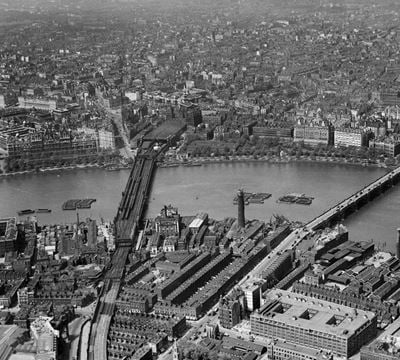
London
The South Bank, Hungerford Bridge and Charing Cross, London, 1921
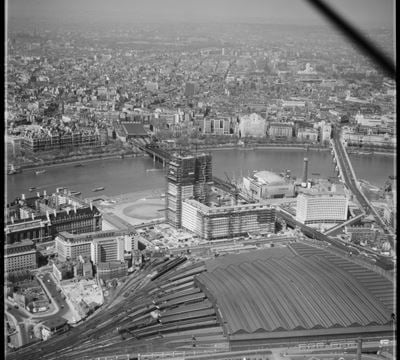
Lambeth
Waterloo Station and construction of the Shell Centre, South Bank, London, 1960
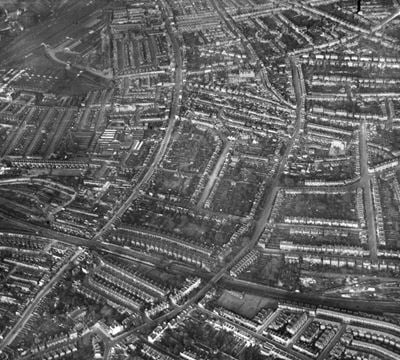
Clapham
Larkhall Rise and environs, Clapham, 1926
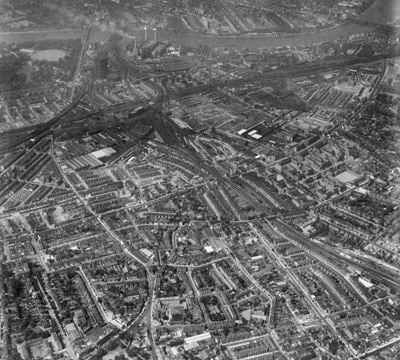
Clapham
Silverthorne Road, Wandsworth Road and environs, Clapham, 1950
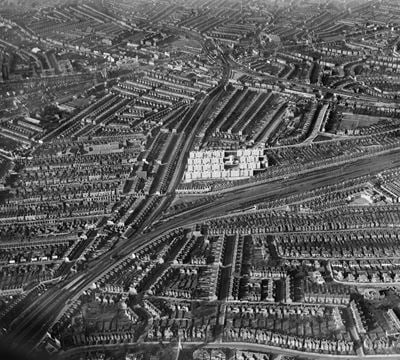
Brixton
Herne Hill North Railway Junction and the surrounding residential area, Brixton, 1939

Brixton
Flats at Herne Hill, Brixton, 1946
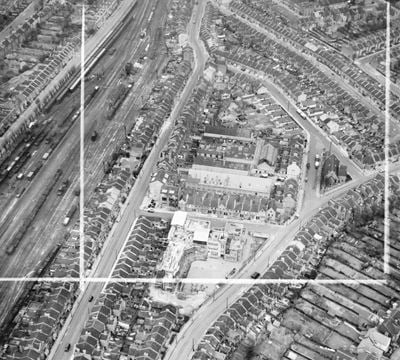
Herne Hill
H.W. Nevill Ltd Bakery on Milkwood Road and environs, Herne Hill, 1950
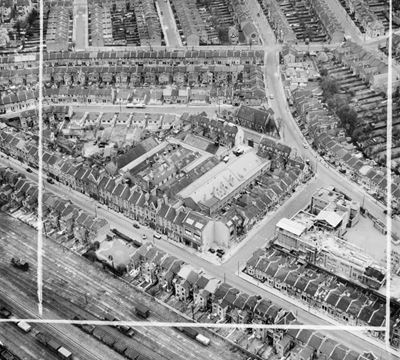
Herne Hill
H.W. Nevill Ltd Bakery on Milkwood Road and environs, Herne Hill, 1950

Brixton
Henley & James Ltd Manufacturing Chemists on Coldharbour Lane, Brixton, 1950
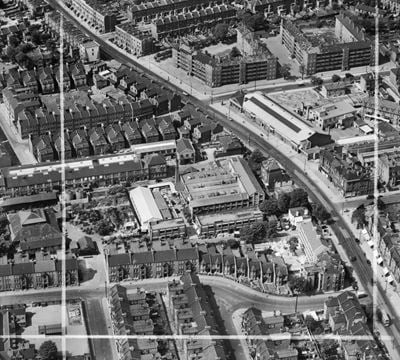
Brixton
Henley & James Ltd Manufacturing Chemists on Coldharbour Lane, Brixton, 1950
Lambeth in the Historic England Archive
The Historic England Archive cares for over 15 million images, dating from the 1850s to the present day. Discover stunning images of Lambeth's past. Skip this section and go to stories about heritage
Charles George Harper Collection
Lambeth, Greater London Authority
Date created: 1892 - 1933
A woman and child walking past the front of 8 Bolwell Street, the birthplace of Arthur Sullivan
Eric de Mare
West Norwood, Lambeth, Greater London Authority
Date created: Circa 1970
Detail view of an angel kneeling beside an unidentified chest tomb in the Greek Orthodox Cemetrey in West Norwood.
John Gay Collection: Railway Stations
Lambeth, Greater London Authority
Date created: 1960 - 1972
Elevated view looking along the railway line from Waterloo Station towards the Shell Building, Hungerford Bridge and the Royal Festival Hall.
John Gay Collection: London
Brixton, Lambeth, Greater London Authority
Date created: Jan 1962 - May 1964
The interior of a fishmonger's shop in Brixton, possibly in a market, showing a lady behind the counter looking at the camera and a customer in the...
John Gay Collection: Highgate and Hampstead
Greater London Authority
Date created: 1991
Detail of an shell hood with acanthus decoration above the doorway of a house, probably in or around Highgate
John Gay Collection: Modern Architects
Lambeth, Greater London Authority
Date created: 1976 - 1979
The stalls and sinks in the toilets at Witchwood House nursery, a low rise block of housing with day nursery at ground floor level, designed by the...
John Gay Collection: Miscellaneous
Greater London Authority
Date created: 19th century
A copy of two images showing rooftop scenes of London sometime in the 19th century
John Gay Collection: Counties
Greater London Authority
Date created: 1959 - 1963
The front of a Rolls Royce Wraith, registration RGO 98
John Laing Collection
Brixton, London, Lambeth, Greater London Authority
Date created: 02 Jul 1984
The construction of a multi-storey red brick extension to Brixton Police Station
Nigel Temple Collection of Postcards of Parks and Gardens
Streatham, Lambeth, Greater London Authority
Date created: 1916 - 1921
VIEW OF THE ENGLISH GARDEN
Walter Scott
Lambeth, Greater London Authority
Date created: 1930 - 1935
A view looking from the north end of Waterloo Bridge towards the south bank of the River Thames where fireboats are extinguishing a blaze near...
Nigel Temple Collection of Postcards of Parks and Gardens
Streatham, Lambeth, Greater London Authority
Date created: 1919 - 1924
GENERAL VIEW DOWN STEPS
Stories about heritage in your local area
Historic England publishes news, blogs, research, videos, and podcasts celebrating England's rich heritage. Discover the stories we have about Lambeth. Skip this section and go to education
The Timeless Charm of English Market Towns and Halls
Mentions Brixton Markets - Reliance Arcade, Market Row and Granville Arcade (Brixton Village)
Discover the history of English market towns and halls, including farmers' markets, Christmas markets, market squares and corn exchanges.
The History of 10 English Cricket Grounds
Mentions No 1 gasholder, Kennington Lane Gasholder Station
By the 18th century, cricket was a leading sport in London and the south eastern counties of England.
How Tutankhamun Influenced 20th Century Design and Architecture
Mentions Brixton Markets - Reliance Arcade, Market Row and Granville Arcade (Brixton Village)
From the most expensive jewellery and furniture to public buildings, learn now Tutankhamun inspired the world of design and popular culture.
A Brief History of Buddhist Temples in England
Mentions Western Block of Number 39 (The Former Beaufoy Institute), Former Lambeth Magistrates' Court
There are around 190 Buddhist buildings in England, ranging from adapted historic buildings to purpose-built temples and pagodas.
13 Architectural Details That Reveal London’s Working History
Mentions Southbank House
London is full of visual clues about its rich past.
11 Unusual Architectural Details That Reveal London’s Secret History
Mentions Lambeth Fire Station (formerly also the London Fire Brigade Headquarters) and ventilation obelisk
High up on London’s walls you will find historic and modern sculpted figures.
A Brief Introduction to Gasholders
Mentions No 1 gasholder, Kennington Lane Gasholder Station
Gasworks once brought light and warmth to homes across England.
7 Places That Tell Stories of the Windrush Generation
Mentions Brixton Markets - Reliance Arcade, Market Row and Granville Arcade (Brixton Village), Brixton Recreation Centre
The arrival of the Windrush generation in 1948 marked the dawn of modern multicultural Britain.
Where to Find Byzantine Architecture in England
Mentions Christ Church
Byzantium made an unexpected mark in the 19th-century as part of a mini-revival across Europe. Here’s where you can find examples in England.
8 of England’s Most Magnificent Libraries
Mentions Royal Festival Hall
Libraries are ingrained into the blueprints of cities worldwide.
A Brief Introduction to Lidos
Mentions Brockwell Lido
Increasing water safety concerns in the 1920s inspired the creation of outdoor pools with concrete, tiled tanks and water filtration systems.
5 of the best buildings by architect Frederick Gibberd
Mentions 1-218 Pullman Court
A new study explores the sheer range of Gibberd’s work, showing that that he does indeed deserve a place in our narrative of 20th century modern...
Public Parks and Greenspaces Matter
Mentions Lambeth
Evaluating the health and wellbeing value of historic public parks and greenspaces.
The Historic England Research Reports Database: Introducing an Important Resource for Researchers
Mentions Lambeth
An Introduction to the Historic England Research Reports database resource, which contains thousands of reports from decades of research.
Historic England Reveals its Heritage at Risk Register 2021
Mentions Streatham Hill Theatre, Lambeth
Historic England publishes its annual Heritage at Risk Register, the yearly health-check of England’s most valued historic places.
9 Historic Sites Recognised to Celebrate the Festival of Britain’s 70th Anniversary
Mentions Royal Festival Hall, Church of St John with All Saints
Historic sites relisted or upgraded to reflect their important links with the Festival.
Black British History Recognised Through Listings
Mentions Platforms Piece, Bust of Nelson Mandela, Royal Festival Hall, London, Brixton Recreation Centre
Three new listings announced as Historic England partners with BBC on 'Black and British' season
Iconic Oval Cricket Gasholder Listed
Mentions Lambeth
An iconic Victorian gasholder that has been the backdrop to test cricket at The Oval is now listed Grade II.
Royal Vauxhall Tavern Listed
Mentions Royal Vauxhall Tavern
We are delighted that the Minister for Heritage, Tracey Crouch, has listed the Royal Vauxhall Tavern at Grade II on our advice.
Best Inter-War Pubs Listed
Mentions The Duke of Edinburgh
Rare, overlooked buildings are protected and celebrated through listing following extensive research
Lambeth's social history through photos
Over 10,000 images from the Historic England Archive have been specially selected and re-captioned for teachers, students, and anyone who wants to learn more about their local area. Skip this section and go to grant-aided places
West Norwood Library, Streatham, Greater London
Period: 1970s (1970 - 1979)
The children's section in West Norwood Library. The library was built in 1969.
Waterloo Station, York Road, Lambeth, Greater London
Period: 1960s (1960 - 1969)
Elevated view looking across the station concourse towards the platforms with people seated on benches and perusing a branch of W H Smith on the...
Waterloo Station, York Road, Lambeth, Greater London
Waterloo Station, York Road, Lambeth, Greater London
Period: 1960s (1960 - 1969)
A porter pushing a trolley loaded with luggage across the crowded concourse at Waterloo Station
Waterloo Station, York Road, Lambeth, Greater London
Union Jack Club, 91A Waterloo Road, Lambeth, Greater London
Period: World War One (1914 - 1919)
A group of Australian soldiers standing outside the Union Jack Club on Waterloo Road.
Union Jack Club, 91A Waterloo Road, Lambeth, Greater London
St Thomas Hospital, Lambeth, Greater London
Period: Victorian (1837 - 1901)
The hospital was founded with 40 beds in the 12th century by monks of an Augustinian priory.
St Thomas Hospital, Lambeth, Greater London
Spurgeons Orphanage, Stockwell, Brixton, Greater London
Period: Victorian (1837 - 1901)
Children gathered outside an orphanage in 1884, it was built in 1866.
Spurgeons Orphanage, Stockwell, Brixton, Greater London
Royal Festival Hall, Lambeth, Greater London
Period: 1950s (1950 - 1959)
The Royal Festival Concert Hall was built 1949-51. It was designed as part of the Festival of Britain celebrations.
Royal Festival Hall, Lambeth, Greater London
Royal Festival Hall, Belvedere Road, South Bank, Lambeth, London
Period: 1950s (1950 - 1959)
The Royal Festival Hall looking south from Waterloo Bridge, was designed by Sir Robert Matthew and J L Martin.
Royal Festival Hall, Belvedere Road, South Bank, Lambeth, London
Visit grant-aided places near you
These places and buildings have been helped by Historic England's financial grants. Find historic places in your neighbourhood that you never knew existed! Please note that opening times may vary. Skip this section and go to related locations
The Dyce Drinking Fountain, Streatham Green
Restored in 2015, the Grade II listed fountain on Streatham Green, designed by William Dyce R.A.
Discover more
Ready for more local heritage? Take a look at these other places nearby

Southwark
Local Authority District

Wandsworth
Local Authority District
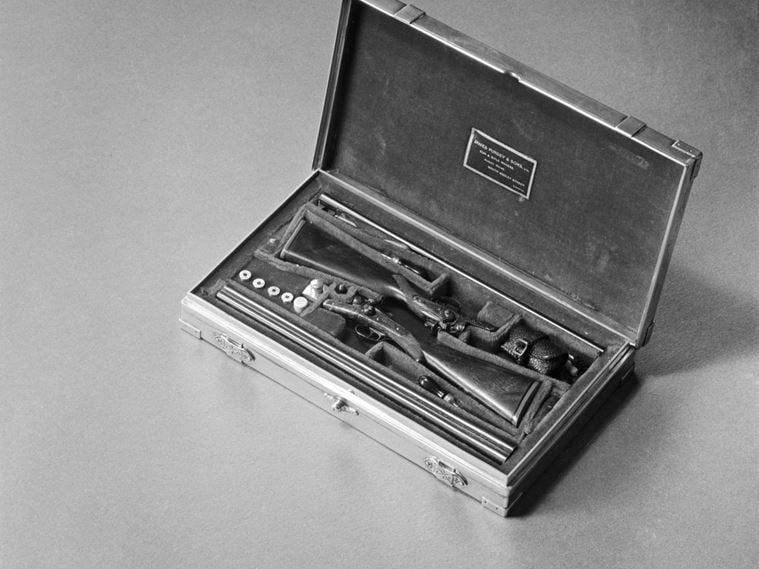
Greater London
Ceremonial County